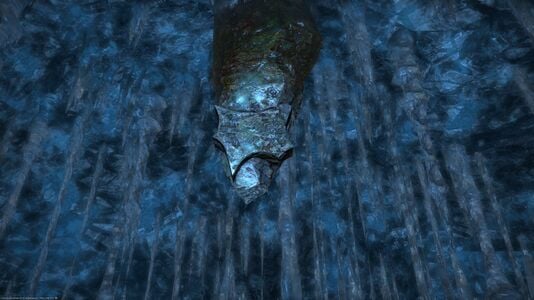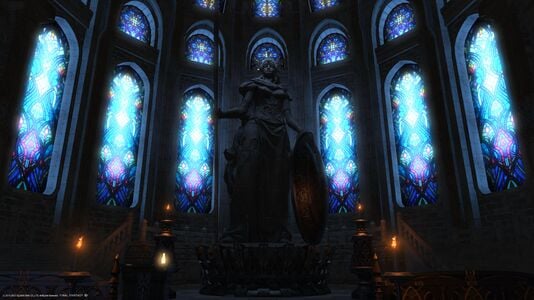Halone

Halone, mover of glaciers and goddess of war, also called the Fury, is the guardian deity of Ishgard. She commands the element of ice and is associated with the first moon of the Eorzean calendar. She is most often depicted as a relentless warrioress armed with a bronze greatshield. Her symbol is the three spears.
Mythology
Eorzean myth says that Halone was "beckoned forth" from The Whorl along with her elder brother Byregot, and both were made wards of Rhalgr by decree of Nymeia. She is also described in this same myth as being a close companion of Oschon, and the bitter rival of Nophica.[1][2][3]
The Heaven and Hell of Ice is said to be the domain of Halone, the heaven of which is a palace of ice made of frozen moonbeams and carved by her spear, where epic heroes and gallant knights reside. From this palace do piercing icicles fall in to The Pit, the Hell of Ice, a freezing domain that punishes cowards, deserters and adulterers.
True Origin
Worship Practices and Organizations
Ishgardian Orthodox Church
In addition to being the city-state's guardian goddess, Halone is the central figure of Ishgard's official religion, the Ishgardian Orthodox Church.
It was roughly around the year 360 of the Sixth Astral Era when the Elezen, forced north into Abalathia's Spine by Hyuran expansion, began the standardization of their faith with the construction of a temple to Halone in the highlands of Coerthas. The settlers' decision to adopt the Fury as a patron deity was likely influenced by the ever-present threat of hostile Dragons. Orthodox Cathedrals are not considered complete without at least one towering statue of Halone, dressed for battle. It has also long been preached that warriors who fell in battle during the Dragonsong War would be welcomed into the Fury's palace, warmly welcomed into the heaven she resides over.[4]
Holy Sites
-
A statue of Halone within Saint Reymanaud's Cathedral in Ishgard.
Saints and Important Figures
Note: these Saints are specifically "blessed" by Halone, but the Ishgardian Orthodox Church has its own set of Saints not mentioned here.
Saint Daniffen
A mercenary who became famous for his valor and daring by slaying a Basilisk that was terrorizing the land. His deeds became recounted as legend in the tale of Saint Daniffen and the Basilisk.[5] Daniffen was also made the namesake of several Coerthan landmarks (such as Daniffen Pass), as well as a system of magical wards that Ishgard once used to defend its city from dragon attacks.
Saint Endalim
An archbishop of the Ishgardian Orthodox Church, Endalim IV removed his crown to mediate a dispute between peasants and lords, his aim to appear as a man of the people rather than a figure of power. The Golden Crown of Saint Endalim celebrates the impartial candor he exemplified in his effort to diffuse the confrontation and prevent bloodshed. He would also be made the namesake of Saint Endalim's Scholasticate in Ishgard.
Saint Finnea
A lady knight who became revered for her unyielding conviction. In spite of being a novice with the blade, she seemed possessed of a spirit that seemed incapable of conceding defeat, and her presence on the battlefield was said to reignite the flagging courage of soldiers who encountered her. The Final Stand of Saint Finnea is the most famous version of her tale. House Jervaint of Ishgard claims to have descended from Saint Finnea's line.
References
- ↑ Encyclopaedia Eorzea I, page 017:
"Byregot is the elder brother of Halone,"
"Rhalgr is the father of both Byregot and Halone, - ↑ The Creation of Eorzea,
"...the Whorl awaoke from its slumber and beckoned forth two final deities-Byregot and His younger sister Halone."
Nymeia quickly made them wards of Rhalgr, the Destroyer." - ↑ Creation of Eorzea: "Though more open to Her new father's teachings, Halone, too, grew restless, longing to test her strength." "Oschon invited the young goddess on one of His journeys. It was during these travels that Halone's ambition slowly transformed into a lust for battle."
- ↑ Encyclopedia Eorzea II, page 021, "The Ishgardian Orthodox Church."
- ↑ Encyclopedia Eorzea II, page 026

